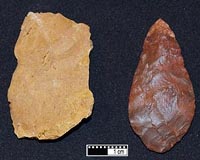| . |  |
. |
Charlottesville VA (SPX) Aug 21, 2009 Massive burning of forests for agriculture thousands of years ago may have increased atmospheric carbon dioxide enough to alter global climate and usher in a warming trend that continues today, according to a new study that appears online Aug. 17 in the journal Quaternary Science Reviews. Researchers at the University of Virginia and the University of Maryland-Baltimore County say that today's 6 billion people use about 90 percent less land per person for growing food than was used by far smaller populations early in the development of civilization. Those early societies likely relied on slash-and-burn techniques to clear large tracts of land for relatively small levels of food production. "They used more land for farming because they had little incentive to maximize yield from less land, and because there was plenty of forest to burn," said William Ruddiman, the lead author and a professor emeritus of environmental sciences at the University of Virginia. "They may have inadvertently altered the climate." Ruddiman is a climate scientist who specializes in investigating ocean-sediment and ice-core records. In recent years he has searched across scientific disciplines - anthropology, archaeology, population dynamics, climatology - to gain insight into how humans may have affected climate over the millennia. He said that early populations likely used a land-clearing method that involved burning forests, then planting crop seed among the dead stumps in the enriched soil. They would use a large plot until the yield began to decline, and then would burn off another area of forest for planting. They would continue this form of rotation farming, ever expanding the cleared areas as their populations grew. They possibly cleared five or more times more land than they actually farmed at any given time. It was only as populations grew much larger, and less land was available for farming or for laying fallow, that societies adopted more intensive farming techniques and slowly gained more food yield from less land. Ruddiman notes that with the highly efficient and intensive farming of today, growing populations are using less land per capita for agriculture. Forests are returning in many parts of the world, including the northeastern United States, Europe, Canada, Russia and even parts of China. The positive environmental effects of this reforestation, however, are being canceled out by the large-scale burning of fossil fuels since the advent of the Industrial Revolution, which began about 150 years ago. Humans continue to add excessive levels of carbon dioxide to the atmosphere, contributing to a global warming trend, Ruddiman said. Five years ago, Ruddiman made headlines with a hypothesis that humans began altering global climate thousands of years ago, not just since the Industrial Revolution. That theory has since been criticized by some climate scientists who believe that early populations were too small to create enough carbon dioxide to alter climate. According to projections from some models of past land use, large-scale land clearing and resulting carbon emissions have only occurred during the industrial era, as a result of huge increases in population. But Ruddiman, and his co-author Erle Ellis, an ecologist at UMBC who specializes in land-use change, say these models are not accounting for the possibly large effects on climate likely caused by early farming methods. "Many climate models assume that land use in the past was similar to land use today; and that the great population explosion of the past 150 years has increased land use proportionally," Ellis said. "We are proposing that much smaller earlier populations used much more land per person, and may have more greatly affected climate than current models reflect." Ruddiman and Ellis based their finding on several studies by anthropologists, archaeologists and paleoecologists indicating that early civilizations used a great amount of land to grow relatively small amounts of food. The researchers compared what they found with the way most land-use models are designed, and found a disconnect between modeling and field-based studies. "It was only as our populations grew larger over thousands of years, and needed more food, that we improved farming technologies enough to begin using less land for more yield," Ruddiman said. "We suggest in this paper that climate modelers might consider how land use has changed over time, and how this may have affected the climate." Share This Article With Planet Earth
Related Links University of Virginia All About Human Beings and How We Got To Be Here
 Early Modern Humans Use Fire To Engineer Tools From Stone
Early Modern Humans Use Fire To Engineer Tools From StoneTempe AZ (SPX) Aug 17, 2009 Evidence that early modern humans living on the coast of the far southern tip of Africa 72,000 years ago employed pyrotechnology - the controlled use of fire - to increase the quality and efficiency of their stone tool manufacturing process. An international team of researchers, including three from the Institute of Human Origins at Arizona State University, deduce that "this technology ... read more |
|
| The content herein, unless otherwise known to be public domain, are Copyright 1995-2009 - SpaceDaily. AFP and UPI Wire Stories are copyright Agence France-Presse and United Press International. ESA Portal Reports are copyright European Space Agency. All NASA sourced material is public domain. Additional copyrights may apply in whole or part to other bona fide parties. Advertising does not imply endorsement,agreement or approval of any opinions, statements or information provided by SpaceDaily on any Web page published or hosted by SpaceDaily. Privacy Statement |